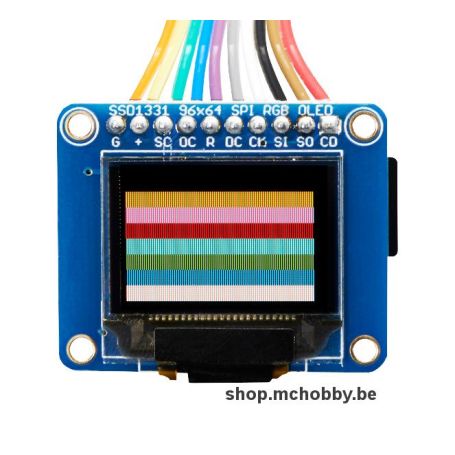Graphic OLED display 96x64 -16 bits colors - 1" - SSD1331
OLED RGB graphical display
- 24.4mm diagonal (0.96")
- 96 (RGB) x 64 pixels
- 16 bits colors
- SSD1331
- SPI bus
- microSD connector
Payments are secured by LyraCollect, a French payment collection company.
It is possible to delivered to your home, to a pick-up point or picked up by appointment at MCHobby
We prepare, pack and ship your orders with great respect and care.
A small OLED RGB graphical display for high integration project
The black and white monochrome OLED displays are great to display data but adding RGB color to OLED display would be fabulous. The new 0.96" (24.4mm) color OLED displays is perfect to add lot of color (16 bit) and high contrast to your project. The visible portion of the OLED make 24.4mm diagonal and the display contains 96 RGB pixels x 64 lines. Each pixel is made with a red, green and blue OLEDs and can be set with 16-bits of resolution. 16 bits colors offer a wide range of color. Thanks to the OLED technology, there is no need for backlight light, and the contrast is very high (black is really black). This display offers an vivid colors, it is the most beautiful mini OLED display!
The OLED is driven by the SSD1331 chip which manages the display. The chip offer an SPI interface to the microcontroler (4-wire write-only with the pins clock, data, chip select, data/command and an optional reset pin). The breakout board is fully assembled and bring the OLED display, a boost converter (providing 12V to the OLED) and a microSD card holder. The board design with logic level shifter so the breakout can be used with 3-5VDC power and logic levels. The example code from Adafruit shows how to read a bitmap from the µSD card and display it via SPI.
Technical details
- Datasheet, Fritzing, EagleCAD file and GitHub availables from the Adafruit's tutorial (english)
- OLED 24.4mm (0.96") diagonal, 16-bits color
- 96 x 64 RGB pixels
- SSD1331 drivers
- SPI Interface
- Logic & power: 3.3-5V
- microSD connector
- Size: 31.5mm x 35.5 x 5mm
The current drawed by the display depend on the usage of the screen: each OLED LED draw some current to produce light. As a consequence, more there is LED brilling more current the screen draws. The mean consumption is about ~25mA (without microSD card) but you will need to use a powermeter to read the consumption corresponding to your particular usage.
Tutoriels
- 0.96" mini Color OLED (Anglais, Adafruit)
Mini color OLED displays - World's Smallest MAME Arcade Cabinet (Anglais, Adafruit)
Made with Pi Zero and 0.96" OLED
- Interface : Connector
- BREAKOUT
- Interface : Bus
- SPI
- Interface : Logic
- equal Vcc
- Interface : Vcc (power)
- 3V3, 5V










